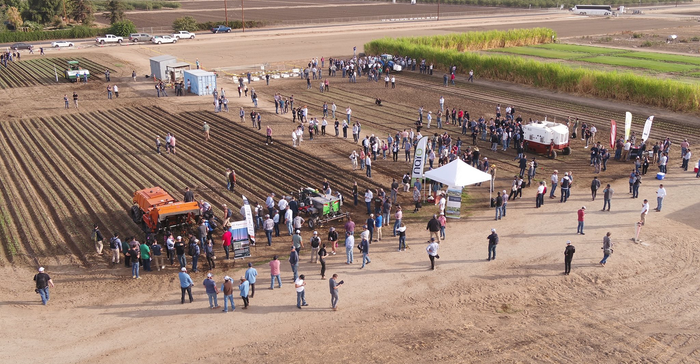
IN-PERSON TECH: On demo day machines crawled back and forth as onlookers scrutinized lasers and listened to product experts explain how the machines work.GOFAR/FIRA
Crop robots may not appear in corn belt fields any time soon, but an extraordinary event happened last week that made it clear autonomous farm gadgets are gaining a foothold, at least in specialty crop farming.
We’re talking about real Star Wars stuff: Driverless cultivators that identify and zap weeds with laser beams. Implements that snap millions of crop photos in real time and use that data to shoot microjets of fertilizer and herbicides in exactly the right place, saving farmers thousands. Tractors with no gas tanks that drive themselves through a field to spray orchards or haul dairy feed to animals.
We saw all of them in Fresno, CA at the first-ever forum dedicated to autonomous solutions and robots for farming. Organizers FIRA USA anticipated 800 attendees, but nearly 1,000 growers and agtech partners flooded in to learn about research and watch machines in action. On demo day machines crawled back and forth as onlookers scrutinized lasers and listened to product experts explain how the machines work.
Sure, it’s early days, but every ground breaking technology has a starting point. The ag labor shortage is not going away. None of these machines ever need a break, a raise, or a nap. They will never join a union, or call in sick. They will work all day and night if you want them to.
First, a definition
What exactly are these things? While they don’t have arms and legs, presenters at the forum did offer this definition: “Crop robots are machines that use hardware and software to perceive surroundings, analyze data and take real-time action on information related to an agricultural crop-related function without human intervention.”
Nearly all the machines have some iteration of machine learning, computer vision and artificial intelligence at work. Many were just an idea in an engineer or entrepreneur’s mind a few years ago. Those who succeed in this sector all echoed a similar theme: to make your product scalable and commercial you must first listen to farmer needs and vet the machines in real world farm conditions. With timely venture capital many are now in farm fields doing precision applications, cutting costs, boosting sustainability, and solving at least some of agriculture’s labor crisis.
To be sure these are early days, and these products are mainly limited right now to specialty or organic crops. But this event definitely had all the signs of a major disruption to farming. The FIRA USA forum was a coming out party for ag automation. It’s just beginning.
Meet some of the people and equipment reshaping the way farming gets accomplished.
Farmwise Titan
Farmwise deployed an autonomous robot cultivator called Titan that uses cameras to identify weeds and mechanically knock them out – even inside a row. The weeding machine is built for specialty crops in California’s Salinas Valley, but the company has big plans to convert the tech to row crop fields in the Midwest in the next few years.
Carbon Robotics weeder
This autonomous laser weeder by Carbon Robotics moves slowly through a field, using cameras to identify weeds and burn them with lasers, avoiding crop plants. This particular machine, for demonstration purposes, is a third the size of the machines being sold to growers.
Orio Naïo
This is Orio, an autonomous tool carrier for vegetables and industrial crops. It’s one of four robots offered by Naïo, a French robot company that’s been in business 10 years and is now expanding to U.S. specialty crops. All machines are fully electric, fully autonomous, and all have RTK/GPS navigation.
About the Author(s)
You May Also Like






